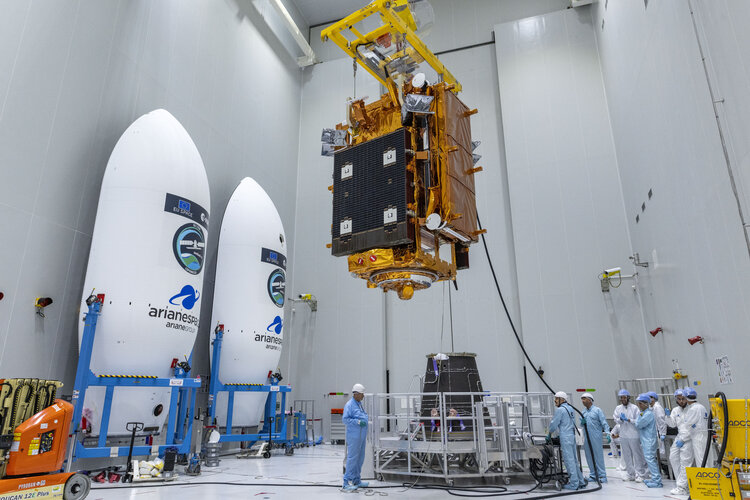Placing the Earth-observer Sentinel-1C onto its "vampire" payload launch adapter to connect the satellite to the Vega-C rocket that will launch it into a polar orbit, 19 November 2024 at Europe Spaceport's payload integration facility.
Earth-observer Sentinel-1C is set to launch on Vega-C rocket flight VV25. At 35 m tall, Vega-C weighs 210 tonnes on the launch pad and reaches orbit with three solid-propellant-powered stages before the fourth liquid-propellant stage takes over for precise placement of Sentinel-1C into its orbit.
The payload adapter connects the satellite and the rocket launching it. The VAMPIRE backronym stands for Vega Adapter for Multiple Payload Injection and Release.
Visible left are the two fairing halves that will protect Sentinel-1C from the elements on the launch pad and during launch through our atmosphere.
Carrying advanced radar technology to provide an all-weather, day-and-night supply of imagery of Earth’s surface, the ambitious Copernicus Sentinel-1 mission has raised the bar for spaceborne radar.
The mission benefits numerous Copernicus services and applications such as those that relate to Arctic sea-ice monitoring, iceberg tracking, routine sea-ice mapping, glacier-velocity monitoring, surveillance of the marine environment including oil-spill monitoring and ship detection for maritime security as well as illegal fisheries monitoring.
Europe’s Vega-C rocket can launch 2300 kg into space, such as small scientific and Earth observation spacecraft. Vega-C is the evolution of the Vega family of rockets and delivers increased performance, greater payload volume and improved competitiveness.



 Image:
Moving Sentinel-1C to Vega-C's Vampire payload adapter
Image:
Moving Sentinel-1C to Vega-C's Vampire payload adapter